ENACT: Energy-Aware, Actionable Twin Utilizing Prescriptive Techniques in Home Appliances
Abstract
Highlights
- A novel digital twin (DT) framework (ENACT) was developed, integrating real-time sensor data, spatial 3D modeling, and AI-based prescriptive maintenance strategies for household appliances.
- Deployment across 20 homes over one year demonstrated strong usability (SUS: 80.5), user engagement, and a behavioral shift toward proactive appliance care, with energy savings of up to 30%.
- Combining spatial visualization with AI-powered recommendations significantly enhances user awareness and engagement, bridging the gap between technical diagnostics and actionable behavior.
- The ENACT system enables sustainable home appliance management by extending device lifespan, reducing energy consumption, and transforming maintenance into a user-centered, preventive practice.
Abstract
1. Introduction
- Hybrid Digital Twin Architecture: A modular DT system that integrates real-time telemetry with spatially contextual 3D models of the home environment;
- Dual Prescriptive Intelligence Models (PRISM): Two specialized AI-driven models tailored to on-demand and continuous appliance operations, delivering actionable maintenance guidance;
- An Immersive, User-Centered Feedback Loop: A behavior-aware interface that transforms diagnostics into intuitive 3D overlays and categorized alerts, improving user awareness and decision-making;
- Contextual Integration of Data and Interaction: Bridging sensor-level insights with user behavior through spatial mapping and interactive prescription delivery.
2. Literature Review
2.1. Digital Twins in Smart Home Environments
2.2. Prescriptive Maintenance Techniques
2.3. Awareness and Decision-Making in Maintenance
3. Methodology
3.1. An Overview of the ENACT Framework
3.2. The IoT Setup, Floor Plan Design, and Appliance Modeling
3.2.1. Smart Home IoT Infrastructure
3.2.2. Floor Plan Design with Grid4Space
3.2.3. Appliance Placement and Metadata Integration
3.3. Functional and 3D Modeling Objectives
3.3.1. 3D Modeling of the Residential Space
3.3.2. Digital Twin Integration and Data Binding
3.4. The Implementation of Prescriptive Techniques
3.4.1. Prescriptive Maintenance for On-Demand Appliances
- Feature Engineering: Power consumption data was preprocessed (including smoothing and decomposition to enhance the signal quality), segmented into operating cycles, and subjected to statistical feature extraction.
- Program Classification: Extracted operational cycles were categorized into programs with similar features using an XGBoost classifier, enabling the differentiation of on-demand devices programs by duration, temperature, and other usage context.
- Anomaly Detection: A CNN-LSTM VAE was trained per program class to reconstruct typical power profiles. Additionally, a dynamic anomaly threshold was calculated using the 3-sigma rule, adapting to signal variability for robust classification of normal and anomalous behavior.
- Prescriptive Output: Detected anomalies enable specific maintenance actions, and the digital twin system highlights affected components offering real-time feedback to the user.
3.4.2. Prescriptive Maintenance for Constantly-On Appliances
- Device Type and Operation Mode Detection: A preprocessing module classifies the appliance’s operational characteristics (fixed-state vs. variable-state operation) using cumulative distribution function (CDF) analysis and the ensemble classifier AdaBoost.
- Feature Compression and Normalization: Power consumption data is resampled to 10-min intervals, normalized, and transformed using a Principal Component Analysis (PCA) to reduce the noise and dimensionality.
- Phase Classification: Processed power profiles are input into an LSTM model that segments the data into distinct operational phases (e.g., active, idle, standby, high-load). These phases represent the recurring behavioral states of the appliance. Changes in the phase duration, frequency, or transition patterns indicate potential degradation or inefficiencies.
- Anomalies in phase behavior trigger contextual maintenance suggestions, such as component inspection, sensor recalibration, or airflow optimization.
3.4.3. Summary of Prescriptive Models
4. User-Centered Interaction and Deployment
4.1. Prescription Delivery and Awareness Strategies
- Visual Overlays: Faulty appliances are color-coded (e.g., orange for minor, red for major issues).
- Contextual Pop-Ups: Each alert includes a timestamp, the recommended action, and the estimated energy impact.
- The Notification System: Mobile push notifications ensure a timely user response even when not actively using the application.
4.2. Use Case Scenarios
4.2.1. Use Case 1: Emergency Intervention
4.2.2. Use Case 2: Minor Intervention
4.2.3. Use Case 3: Routine Maintenance Notifications
4.2.4. Use Case 4: Normal Operation
4.2.5. Use Case 5: Disconnected/No Data
4.3. Behavioral Impact and Usability Assessment
- BQ1. Using ENACT made me more aware of how much energy my household appliances consume.
- BQ2. The recommendations of ENACT motivated me to take maintenance actions that I would have otherwise ignored.
- BQ3. Since using ENACT, I have changed the way I think about appliance longevity and energy efficiency.
- BQ4. I feel more confident in managing the maintenance of my appliances thanks to ENACT.
- BQ5. At the end of the questionnaire, participants were also invited to respond to the following open-ended question: “What feature or aspect of the system did you find most helpful or appealing? Feel free to share any additional comments or suggestions”.
5. The Experimental Results
5.1. The Experimental Setup
5.1.1. Deployment Conditions
5.1.2. Participant Characteristics
5.1.3. Events and Prescriptions
5.2. Deployment Feasibility and Cost Analysis
5.3. Use Case Scenarios
5.3.1. Use Case 1: Emergency Intervention
5.3.2. Use Case 2: Minor Intervention
5.3.3. Use Case 3: Routine Maintenance Notification
5.3.4. Use Case 4: Normal Operation
5.3.5. Use Case 5: Disconnected/No Data
5.4. System Flow: From 2D Design to the Digital Twin
5.5. Performance Assessment of the PRISM Maintenance Models
5.6. Baselines and Comparative Analysis
5.7. User Engagement and Awareness Outcomes
Analysis of User Behavior Changes and Energy Implications
6. Discussion
6.1. Scalability, Cybersecurity, and Smart City Integration
6.2. The Advantages of the CNN-LSTM VAE over Traditional Methods
7. Conclusions
Author Contributions
Funding
Informed Consent Statement
Data Availability Statement
Conflicts of Interest
Appendix A. User Questionnaire
References
- European Commission. Energy Performance of Buildings Directive. Available online: https://energy.ec.europa.eu/topics/energy-efficiency/energy-efficient-buildings/energy-performance-buildings-directive_en (accessed on 1 April 2025).
- Dimara, A.; Timplalexis, C.; Krinidis, S.; Schneider, C.; Bertocchi, M.; Tzovaras, D. Optimal comfort conditions in residential houses. In Proceedings of the 2020 5th International Conference on Smart and Sustainable Technologies (SpliTech), Virtual, 23–26 September 2020; pp. 1–6. [Google Scholar]
- Sayed, A.N.; Bensaali, F.; Himeur, Y.; Dimitrakopoulos, G.; Varlamis, I. Enhancing building sustainability: A Digital Twin approach to energy efficiency and occupancy monitoring. Energy Build. 2025, 328, 115151. [Google Scholar] [CrossRef]
- Rojek, I.; Mikołajewski, D.; Dostatni, E. Digital twins in product lifecycle for sustainability in manufacturing and maintenance. Appl. Sci. 2020, 11, 31. [Google Scholar] [CrossRef]
- Laitala, K.; Klepp, I.G.; Haugrønning, V.; Throne-Holst, H.; Strandbakken, P. Increasing repair of household appliances, mobile phones and clothing: Experiences from consumers and the repair industry. J. Clean. Prod. 2021, 282, 125349. [Google Scholar] [CrossRef]
- Magnier, L.; Mugge, R. Replaced too soon? An exploration of Western European consumers’ replacement of electronic products. Resour. Conserv. Recycl. 2022, 185, 106448. [Google Scholar] [CrossRef]
- Dimara, A.; Tzitziou, G.; Papaioannou, A.; Krinidis, S.; Anagnostopoulos, C.N.; Ioannidis, D.; Tzovaras, D. Appliance maintenance behaviors and sustainability: A European household perspective analysis. Resour. Conserv. Recycl. 2024, 210, 107835. [Google Scholar] [CrossRef]
- Jones, D.; Snider, C.; Nassehi, A.; Yon, J.; Hicks, B. Characterising the Digital Twin: A systematic literature review. CIRP J. Manuf. Sci. Technol. 2020, 29, 36–52. [Google Scholar] [CrossRef]
- Elfarri, E.M.; Rasheed, A.; San, O. Artificial intelligence-driven digital twin of a modern house demonstrated in virtual reality. IEEE Access 2023, 11, 35035–35058. [Google Scholar] [CrossRef]
- Liu, B.; He, X.; Li, Y.; Xiao, Y.; Feng, X.; Chen, L.; Yu, L. Design of Intelligent Home Lighting Control System Based on Speech Recognition. In Proceedings of the Green Energy and Networking: 6th EAI International Conference, GreeNets 2019, Dalian, China, 4 May 2019; Proceedings 6. pp. 150–158. [Google Scholar]
- Willcox, K.; Bingham, D.; Chung, C.; Chung, J.; Cruz-Neira, C.; Grant, C.J.; Ye, X. Foundational Research Gaps and Future Directions for Digital Twins; National Academies Press: Washington, DC, USA, 2023. [Google Scholar]
- Peter-Paul, V.; Slob, A. User Behavior and Technology Development; Springer: Dordrecht, The Netherlands, 2006. [Google Scholar]
- Bouchabou, D.; Grosset, J.; Nguyen, S.M.; Lohr, C.; Puig, X. A Smart Home Digital Twin to Support the Recognition of Daily Living Activities. Sensors 2023, 23, 7586. [Google Scholar] [CrossRef]
- Motlagh, N.H.; Zaidan, M.A.; Lovén, L.; Fung, P.L.; Hänninen, T.; Morabito, R.; Tarkoma, S. Digital twins for smart spaces—beyond IoT analytics. IEEE Internet Things J. 2023, 11, 573–583. [Google Scholar] [CrossRef]
- Yan, G. Intelligent lighting system based on digital twins in smart home. In Proceedings of the Third International Conference on Control and Intelligent Robotics (ICCIR 2023), Guangzhou, China, 23–25 June 2023; Volume 12940, pp. 323–333. [Google Scholar]
- Singh, S.K.; Kumar, M.; Tanwar, S.; Park, J.H. GRU-based digital twin framework for data allocation and storage in IoT-enabled smart home networks. Future Gener. Comput. Syst. 2024, 153, 391–402. [Google Scholar] [CrossRef]
- Aghazadeh Ardebili, A.; Zappatore, M.; Ramadan, A.I.A.; Longo, A.; Ficarella, A. Digital Twins of Smart Energy Systems: A Systematic Literature Review on Enablers, Design, Management and Computational Challenges. Energy Inform. 2024, 7, 94. [Google Scholar] [CrossRef]
- Palley, B.; Poças Martins, J.; Bernardo, H.; Rossetti, R. Integrating Machine Learning and Digital Twins for Enhanced Smart Building Operation and Energy Management: A Systematic Review. Urban Sci. 2025, 9, 202. [Google Scholar] [CrossRef]
- Tzitziou, G.; Dimara, A.; Papaioannou, A.; Krinidis, S.; Anagnostopoulos, C.N.; Ioannidis, D.; Tzovaras, D. Is the residential sector ready for prescriptive maintenance? A short analysis. In Proceedings of the 2023 IEEE 13th Annual Computing and Communication Workshop and Conference (CCWC), Las Vegas, NA, USA, 8–11 March 2023; pp. 22–28. [Google Scholar]
- Shorfuzzaman, M.; Hossain, M.S. Predictive analytics of energy usage by IOT-based smart home appliances for Green Urban Development. ACM Trans. Internet Technol. (TOIT) 2021, 22, 1–26. [Google Scholar] [CrossRef]
- Powroźnik, P.; Szcześniak, P. Predictive Analytics for Energy Efficiency: Leveraging Machine Learning to Optimize Household Energy Consumption. Energies 2024, 17, 19961073. [Google Scholar] [CrossRef]
- Ghosh, P.; Tyagi, S. Leveraging Big Data Analytics For Predictive Maintenance in Smart Home Appliances. In Proceedings of the 2024 10th International Conference on Electrical Energy Systems (ICEES), Chennai, India, 22–24 February 2024; pp. 1–4. [Google Scholar]
- Papaioannou, A.; Dimara, A.; Krinidis, S.; Anagnostopoulos, C.N.; Ioannidis, D.; Tzovaras, D. Advanced proactive anomaly detection in multi-pattern home appliances for energy optimization. Internet Things 2024, 26, 101175. [Google Scholar] [CrossRef]
- Thammaboosadee, S.; Wongpitak, P. An integration of requirement forecasting and customer segmentation models towards prescriptive analytics for electrical devices production. In Proceedings of the 2018 International Conference on Information Technology (InCIT), Chiang Mai, Thailand, 1–2 November 2018; pp. 1–5. [Google Scholar]
- Choubey, S.; Benton, R.G.; Johnsten, T. A holistic end-to-end prescriptive maintenance framework. Data-Enabled Discov. Appl. 2020, 4, 1–20. [Google Scholar] [CrossRef]
- Mao, H.; Liu, Z.; Qiu, C.; Huang, Y.; Tan, J. Prescriptive Maintenance for Complex Products with Digital Twin Considering Production Planning and Resource Constraints. Meas. Sci. Technol. 2023, 34, 125903. [Google Scholar] [CrossRef]
- Wang, H.; Yu, C.; Zheng, J.; Jia, Y.; Liu, Z.; Yang, K. Digital-Twin-Based Operation and Maintenance Management Method for Large Underground Spaces. Buildings 2024, 14, 2577. [Google Scholar] [CrossRef]
- Cespedes-Cubides, A.S.; Jradi, M. A Review of Building Digital Twins to Improve Energy Efficiency in the Building Operational Stage. Energy Inform. 2024, 7, 11. [Google Scholar] [CrossRef]
- Spigliantini, G.; Fabi, V.; Corgnati, S.P. Towards high energy performing historical buildings. a methodology focused on operation and users’ engagement strategies. Energy Procedia 2017, 134, 376–385. [Google Scholar] [CrossRef][Green Version]
- Bernardini, G.; Di Giuseppe, E.; D’Orazio, M. Towards a user-centered framework to support proactive Building Operation and Maintenance: Preliminary results of a communication platform between users and stakeholders. Technol. Eng. Mater. Archit. 2020, 6, 7–17. [Google Scholar] [CrossRef]
- Bernardini, G.; Di Giuseppe, E. Towards a user-centered and condition-based approach in building operation and maintenance. In Proceedings of the Sustainability in Energy and Buildings: Proceedings of SEB, Budapest, Hungary, 4–5 July 2019; pp. 327–337. [Google Scholar]
- Liu, X.; Jiang, Y.; Huang, Y.; Zhang, H.; Tu, Z. Towards Sustainable Interaction in the Home Appliance Industry: An AI-Powered Dialogue System Approach. In Proceedings of the Eleventh International Symposium of Chinese CHI, Bali, Indonesia, 13–24 November 2023; pp. 556–561. [Google Scholar]
- Grover, A.; Tripathy, B.; Sharma, H.; Gill, A.K.; Panda, S.K. Enhancement in smart homes: AI-driven energy consumption optimization through IoT integration. In Integrated Technologies in Electrical, Electronics and Biotechnology Engineering; CRC Press: Boca Raton, FL, USA, 2025; pp. 300–307. [Google Scholar]
- Malleeshwaran, T.; Prasanna, T. Ai-driven iot framework for optimal energy management in consumer devices. In Proceedings of the 2024 3rd International Conference on Sentiment Analysis and Deep Learning (ICSADL), Bangkok, Thailand, 23–24 August 2024; pp. 746–751. [Google Scholar]
- Salama, M.; Raslen, B. MQTT in Action: Building Reliable and Scalable Home Automation Systems. Sak. Univ. J. Comput. Inf. Sci. 2024, 7, 494–509. [Google Scholar] [CrossRef]
- Papaioannou, C.; Dimara, A.; Tzitzios, I.; Stogia, M.; Anagnostopoulos, C.N.; Krinidis, S. Interactive 2D Design: A User Friendly Grid-Based Approach for Smart Digital Twins. In Artificial Intelligence Applications and Innovations; Papaleonidas, A., Pimenidis, E., Papadopoulos, H., Chochliouros, I., Eds.; AIAI 2025 IFIP WG 12.5 International Workshops; AIAI 2025; IFIP Advances in Information and Communication Technology; Springer: Cham, Switzerland, 2025; Volume 754. [Google Scholar] [CrossRef]
- Papaioannou, A.; Dimara, A.; Krinidis, S.; Tzitziou, G.; Papaioannou, I.; Michailidis, I.; Anagnostopoulos, C.-N.; Ioannidis, D.; Kosmatopoulos, E.; Tzovaras, D. A novel AI-powered method for robust identification of operational phases in refrigerators. Sustain. Energy Grids Netw. 2024, 39, 101405. [Google Scholar] [CrossRef]
- Use Cases GitHub. Available online: https://github.com/christofpap/ENACT (accessed on 9 July 2025).
- Papaioannou, A.; Dimara, A.; Papaioannou, C.; Papaioannou, I.; Krinidis, S.; Anagnostopoulos, C.N.; Korkas, C.; Kosmatopoulos, E.; Ioannidis, D.; Tzovaras, D. Simulation of Malfunctions in Home Appliances’ Power Consumption. Energies 2024, 17, 19961073. [Google Scholar] [CrossRef]
- Shinde, A.; Suryawanshi, R.; Pawar, M. IoT based Smart Home Testbed using MQTT Communication Protocol. Int. J. Eng. Res. Dev. 2020, 12, 317–324. [Google Scholar]
- Islam, A.; Rahman, R.; Alam, M.; Hossain, S. Edge Computing and IoT in Smart Cities—An Overview. In Holistic Research Perspectives; National Foundation for Entrepreneurship Development (NFED): Thiruvananthapuram, India, 2024. [Google Scholar]
- De Rango, F. DLST-MQTT: Dynamic and lightweight security over topics. Comput. Netw. 2025, 166, 107625. [Google Scholar] [CrossRef]
- Singh, P.; Sharma, K.; Gupta, V. A Review of IoT-Based Smart City Development and Management. Smart Cities 2024, 7, 1462–1501. [Google Scholar]


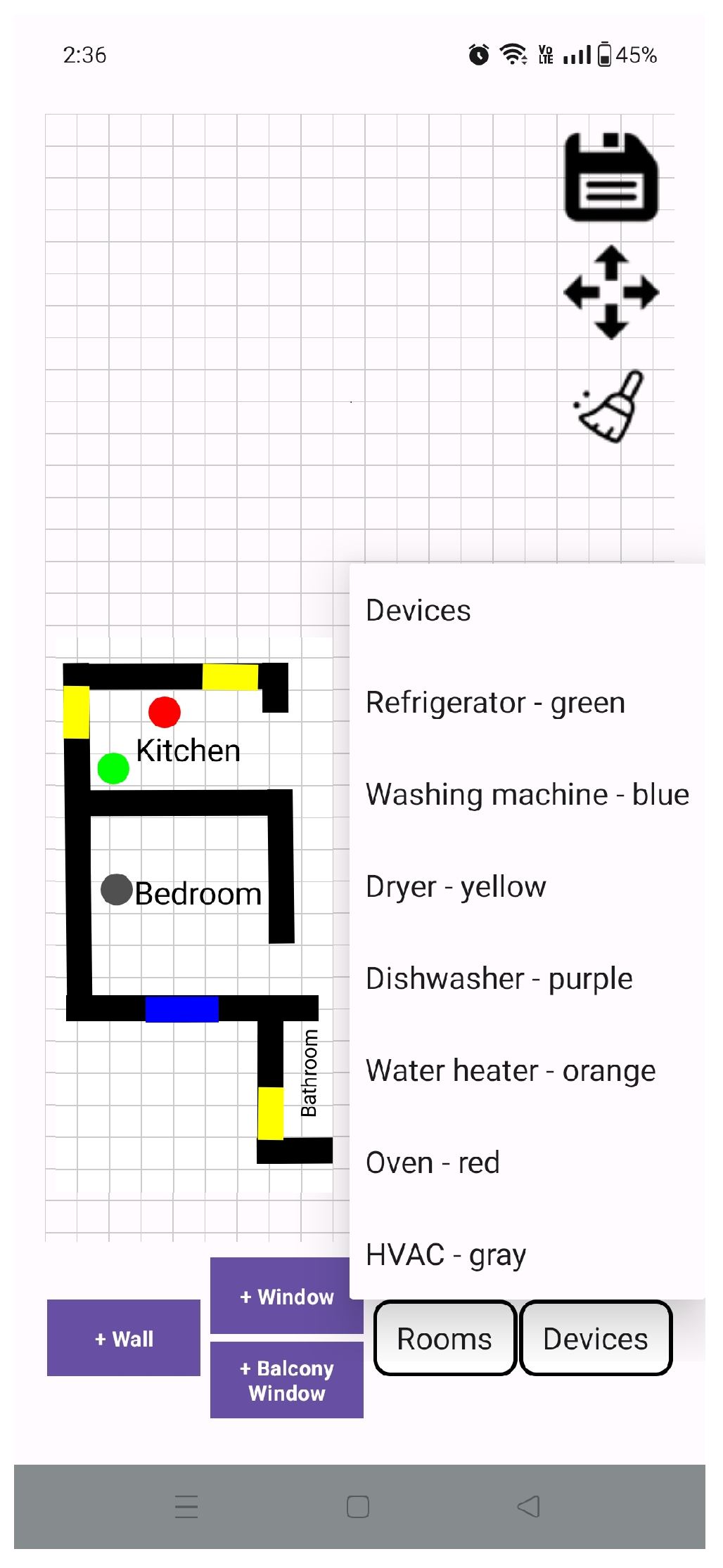


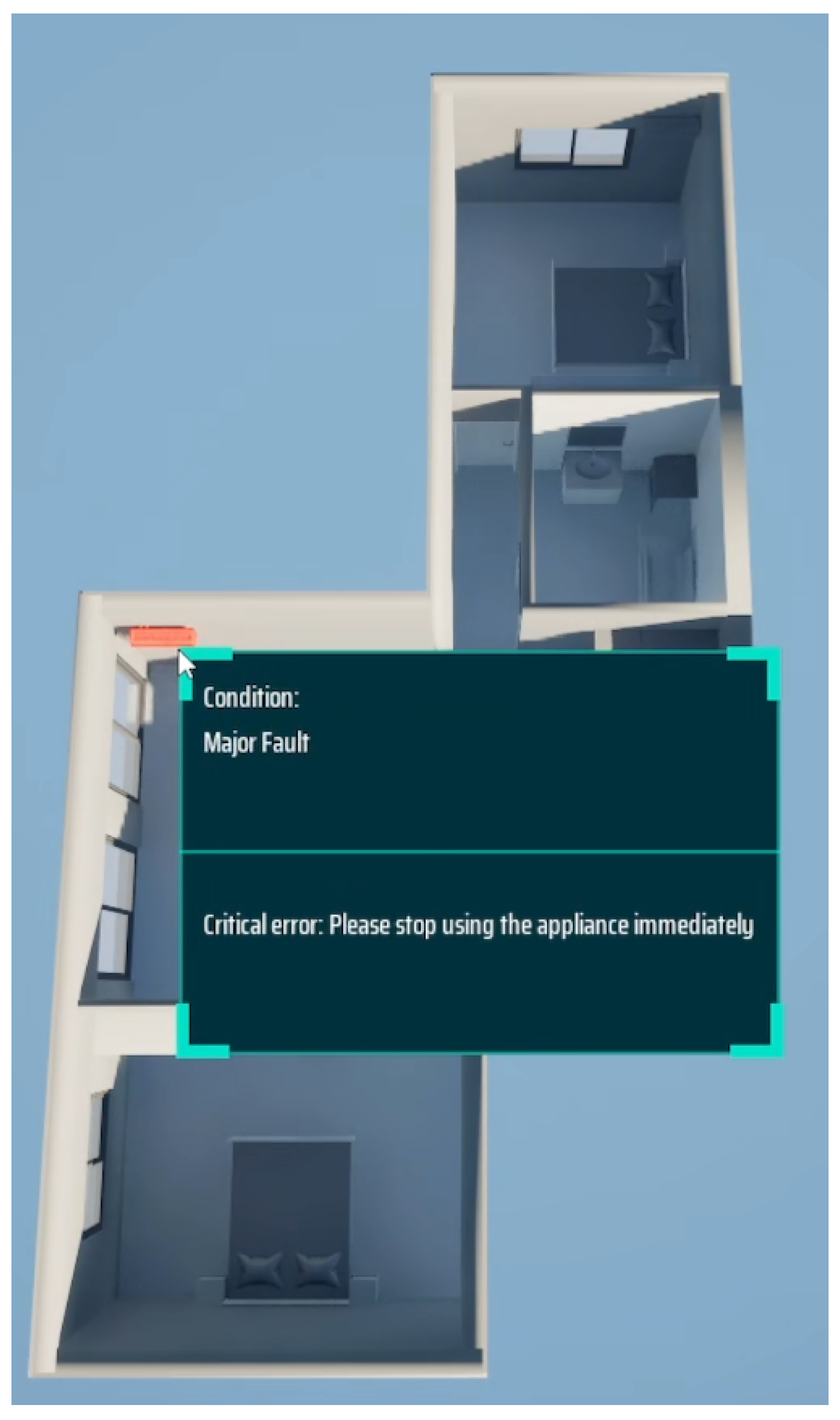
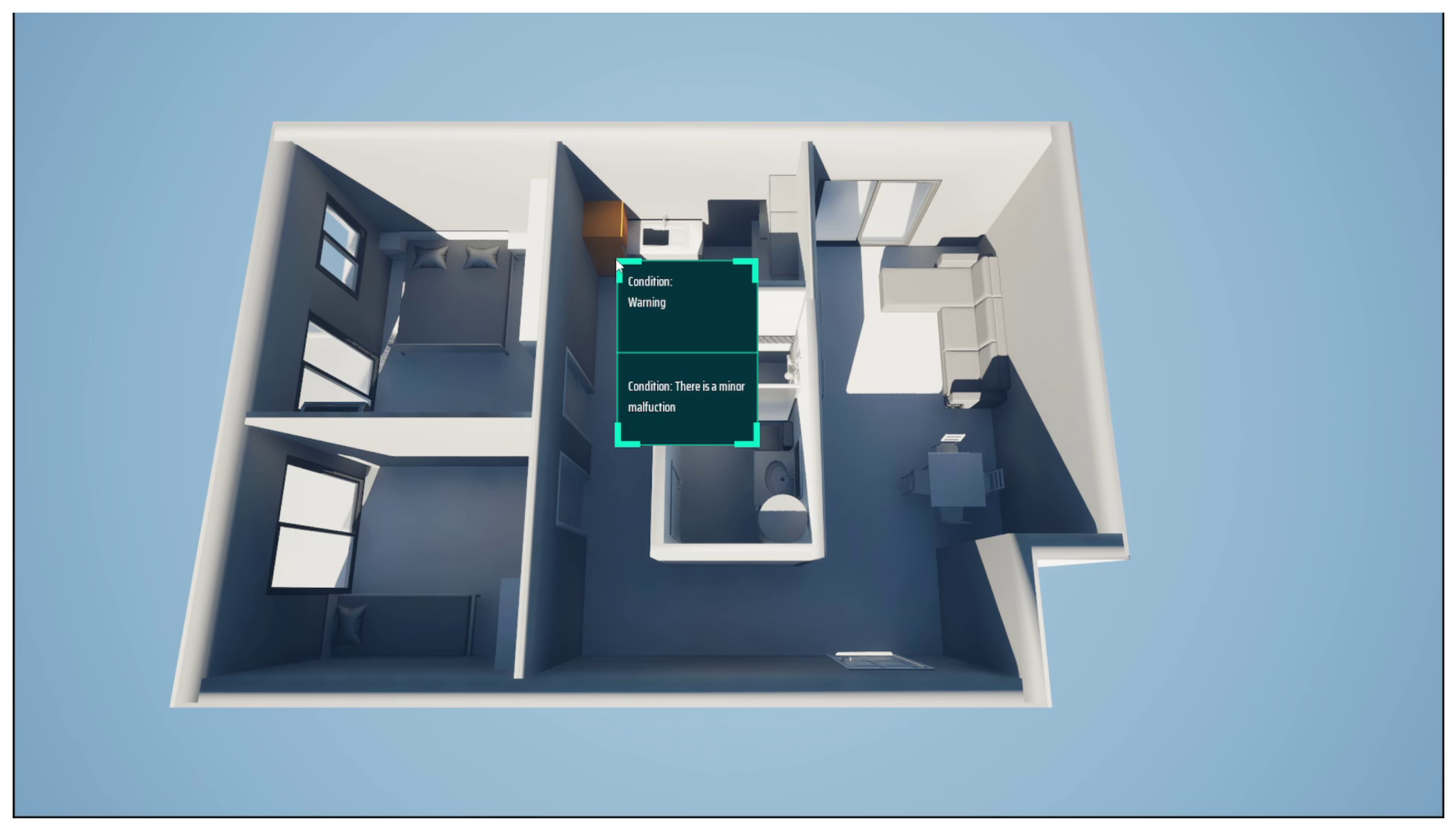
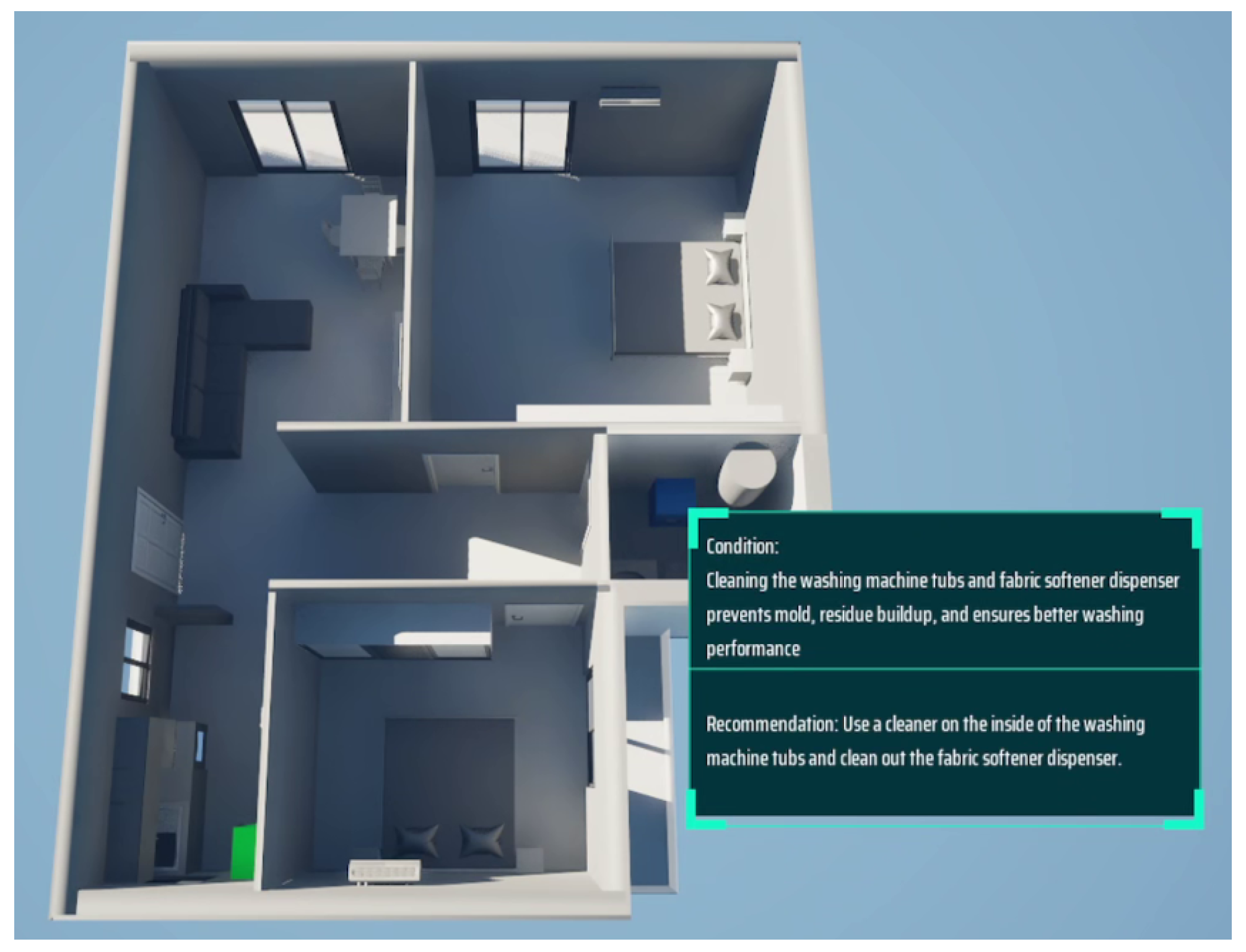

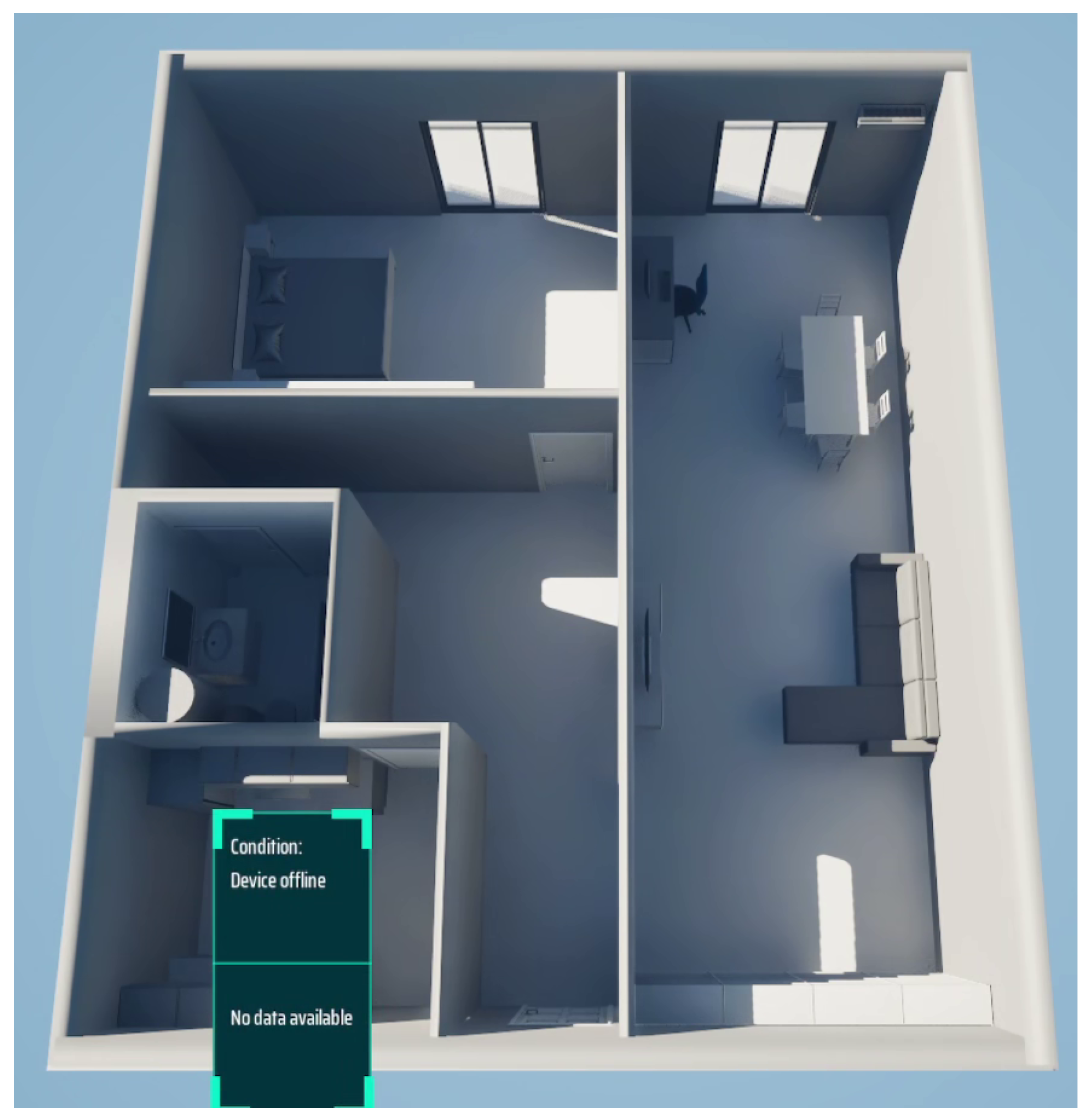
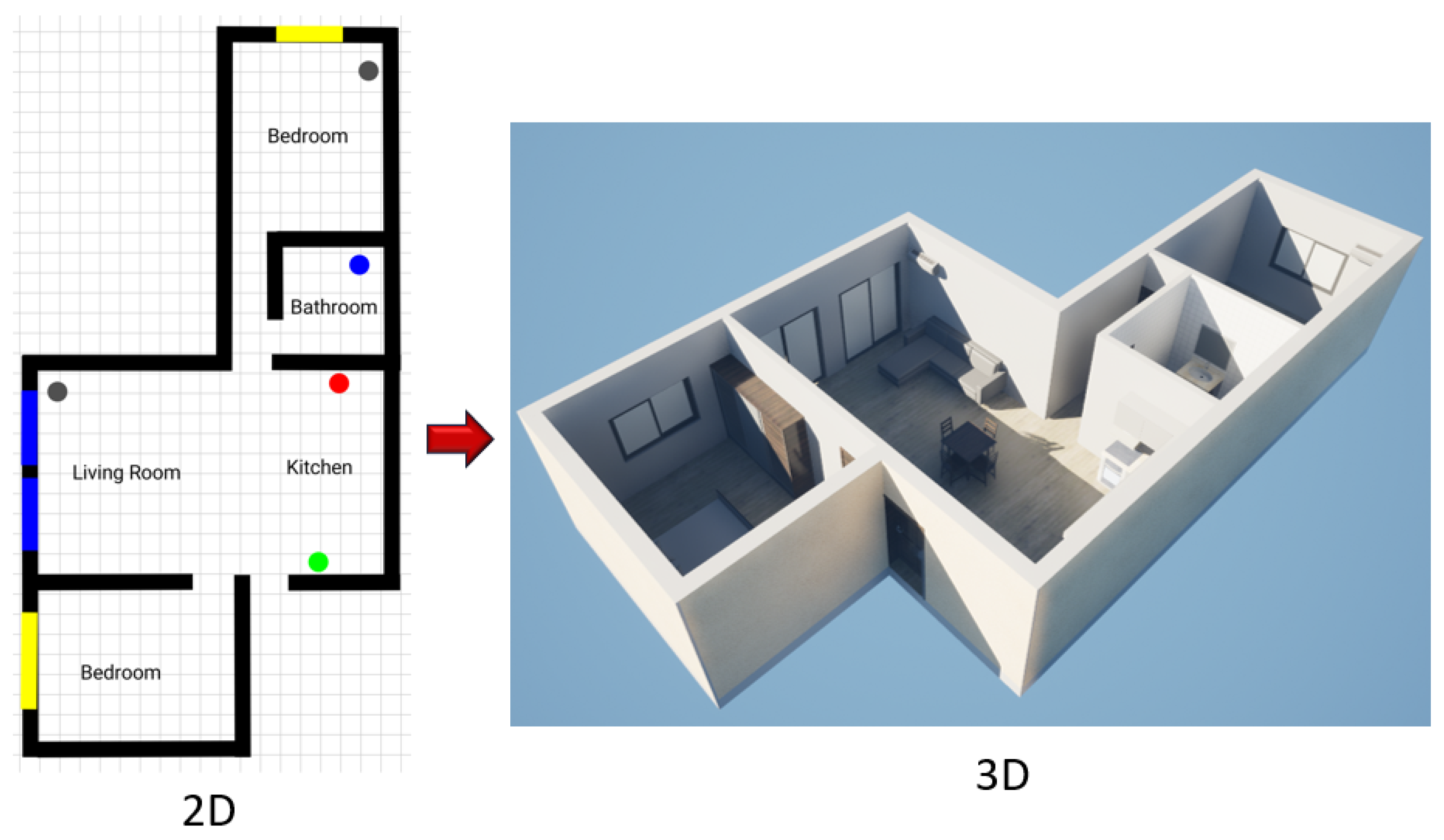
| Study | DT | Maintenance | User Awareness/Interaction | Limitation/Focus |
|---|---|---|---|---|
| [14] | ✓ | – | Limited | Generic DT architecture; no appliance-level maintenance |
| [10] | ✓ | – | – | Device mirroring; lacks prescriptive intelligence |
| [22] | – | Predictive | – | Predictive only; no prescriptive guidance or UI |
| [25] | – | Prescriptive | – | Industrial focus; not residential |
| [30] | – | – | ✓ | User engagement only; no DT or prescriptive maintenance |
| [27] | ✓ | Predictive | – | Building-level focus; not appliance-level or user-centered |
| ENACT | ✓ | Prescriptive ✓ | ✓ | First integrative framework for residential appliances |
| Feature | On-Demand Devices Method | Constantly-On Devices Method |
|---|---|---|
| Appliance Type | Washing machine, dishwasher, oven, dryer, air conditioner | Refrigerator |
| Detection Method | CNN-LSTM VAE | LSTM with AdaBoost for operational mode and behavioral phase classification |
| Classification Approach | XGBoost-based multi-pattern program classification | PCA-based feature compression followed by LSTM classification |
| Prescriptive Recommendations | Task-specific actionable advice based on anomaly type | Maintenance or replacement guidance with energy saving suggestions |
| Energy Saving Impact | Up to 30% reduction in energy consumption | Lifecycle extension and cost efficiency due to proactive degradation detection |
| Prescription Type | Example |
|---|---|
| Guideline | - Clean appliance filters monthly to maintain efficiency. |
| - Avoid overloading the washing machine to reduce wear on the motor. | |
| Routine | - Schedule an HVAC system check-up every 6 months. |
| - Defrost the freezer every 3 months to maintain cooling performance. | |
| Diagnostic—Minor | - A slight increase in energy use detected; clean condenser coils. |
| Diagnostic—Major | - Significant deviation in usage; check for compressor failure or refrigerant leak. |
| Household ID | Monitored Appliances |
|---|---|
| H01 | Refrigerator, Washing Machine, Dishwasher, Oven |
| H02 | Refrigerator, Dishwasher, Oven, Dryer |
| H03 | Refrigerator, Washing Machine, Oven, Air Conditioner |
| H04 | Washing Machine, Dishwasher, Oven, Dryer |
| H05 | Refrigerator, Washing Machine, Dryer, Air Conditioner |
| H06 | Refrigerator, Washing Machine, Dishwasher, Air Conditioner |
| H07 | Washing Machine, Dishwasher, Oven, Air Conditioner |
| H08 | Refrigerator, Washing Machine, Oven, Air Conditioner |
| H09 | Refrigerator, Washing Machine, Dryer, Air Conditioner |
| H10 | Refrigerator, Dishwasher, Oven, Dryer |
| H11 | Refrigerator, Washing Machine, Dishwasher, Dryer |
| H12 | Washing Machine, Dishwasher, Oven, Air Conditioner |
| H13 | Refrigerator, Washing Machine, Oven, Dryer |
| H14 | Refrigerator, Dishwasher, Oven, Air Conditioner |
| H15 | Refrigerator, Washing Machine, Dishwasher, Dryer |
| H16 | Refrigerator, Washing Machine, Dishwasher, Oven |
| H17 | Refrigerator, Washing Machine, Oven, Air Conditioner |
| H18 | Refrigerator, Dishwasher, Oven, Air Conditioner |
| H19 | Refrigerator, Washing Machine, Dryer, Air Conditioner |
| H20 | Refrigerator, Washing Machine, Dishwasher, Dryer |
| Characteristic | Category | Count | Percentage |
|---|---|---|---|
| Household size | 1–2 persons | 6 | 30% |
| 3–4 persons | 9 | 45% | |
| 5+ persons | 5 | 25% | |
| Age of primary user | 25–40 years | 8 | 40% |
| 41–60 years | 9 | 45% | |
| 60+ years | 3 | 15% | |
| Digital literacy * | Low | 4 | 20% |
| Medium | 10 | 50% | |
| High | 6 | 30% |
| Event Type | Total Events | Average per Household | Frequency |
|---|---|---|---|
| Routine maintenance reminders | 120 | 6.0 | every 2 months |
| Prescriptive guidelines | 24 | 1.2 | Condition-based |
| Diagnostic detections (major) | 2 | 0.1 | Event-driven |
| Diagnostic detections (minor) | 6 | 0.3 | Event-driven |
| Item | Cost (USD) | Notes |
|---|---|---|
| IoT hub | $30–50 | ESP32/RPi |
| Smart plugs (4–5) | $60–100 | Major appliances |
| Total per household | $90–150 | Excluding smartphone |
| Appliance Type | Model | Precision | Recall | F1-Score | AUC-ROC | Avg. Energy Saving |
|---|---|---|---|---|---|---|
| Washing Machine | APAD | 0.90 | 0.86 | 0.88 | 0.87 | 26% |
| Dishwasher | APAD | 0.88 | 0.84 | 0.86 | 0.85 | 24% |
| Dryer | APAD | 0.88 | 0.86 | 0.87 | 0.86 | 23% |
| Oven | APAD | 0.87 | 0.89 | 0.88 | 0.87 | 18% |
| Air Conditioner | APAD | 0.87 | 0.85 | 0.86 | 0.85 | 16% |
| Refrigerator | LSTM | 0.89 | 0.88 | 0.88 | 0.87 | N/A |
| Appliance Type | Model | Precision | Recall | F1-Score | AUC-ROC | Avg. Energy Saving |
|---|---|---|---|---|---|---|
| Washing Machine | APAD | 0.94 | 0.92 | 0.93 | 0.94 | 30% |
| Dishwasher | APAD | 0.92 | 0.90 | 0.91 | 0.92 | 28% |
| Dryer | APAD | 0.92 | 0.91 | 0.91 | 0.92 | 27% |
| Oven | APAD | 0.91 | 0.93 | 0.92 | 0.92 | 22% |
| Air Conditioner | APAD | 0.91 | 0.90 | 0.91 | 0.91 | 20% |
| Refrigerator | LSTM | 0.93 | 0.91 | 0.92 | 0.92 | N/A |
| Appliance Type | Model | Precision | Recall | F1-Score | AUC-ROC | Avg. Energy Saving |
|---|---|---|---|---|---|---|
| Washing Machine | APAD | 0.91 | 0.88 | 0.89 | 0.90 | 28% |
| Dishwasher | APAD | 0.89 | 0.86 | 0.87 | 0.88 | 25% |
| Dryer | APAD | 0.90 | 0.88 | 0.89 | 0.89 | 24% |
| Oven | APAD | 0.88 | 0.90 | 0.89 | 0.89 | 19% |
| Air Conditioner | APAD | 0.88 | 0.87 | 0.88 | 0.88 | 17% |
| Refrigerator | LSTM | 0.90 | 0.89 | 0.89 | 0.89 | N/A |
| Appliance Type | Model | Precision | Recall | F1-Score | AUC-ROC | Avg. Energy Saving |
|---|---|---|---|---|---|---|
| Washing Machine | APAD | 0.92 | 0.89 | 0.90 | 0.91 | 28% |
| Dishwasher | APAD | 0.90 | 0.87 | 0.88 | 0.89 | 26% |
| Dryer | APAD | 0.90 | 0.89 | 0.89 | 0.90 | 25% |
| Oven | APAD | 0.89 | 0.91 | 0.90 | 0.90 | 20% |
| Air Conditioner | APAD | 0.89 | 0.88 | 0.88 | 0.89 | 18% |
| Refrigerator | LSTM | 0.91 | 0.90 | 0.90 | 0.90 | N/A |
| Appliance | AUC | AUC (Noisy) | F1 (Missing Data) | Latency (ms) | FPR (%) | Phase Acc. |
|---|---|---|---|---|---|---|
| Washing Machine | 0.94 | 0.92 | 0.87 | 45 | – | – |
| Dishwasher | 0.93 | 0.91 | 0.87 | 40 | 3.4 | – |
| Dryer | 0.92 | – | – | 50 | – | – |
| Oven | 0.90 | – | – | 38 | 4.8 | – |
| Air Conditioner | 0.91 | – | – | 52 | – | – |
| Refrigerator | 0.89 | 0.87 | – | 27 | 2.9 | 89.1% (W), 88.4% (S) |
| Method | Precision | Recall | F1-Score | AUC-ROC | FPR |
|---|---|---|---|---|---|
| PRISM–APAD (on-demand) | 0.90 | 0.89 | 0.90 | 0.90 | 0.04 |
| PRISM–LSTM (refrigerator) | 0.91 | 0.90 | 0.90 | 0.90 | 0.04 |
| LSTM Autoencoder | 0.86 | 0.84 | 0.85 | 0.86 | 0.07 |
| Isolation Forest | 0.82 | 0.80 | 0.81 | 0.83 | 0.09 |
| One-Class SVM | 0.80 | 0.79 | 0.79 | 0.81 | 0.10 |
| Matrix Profile | 0.83 | 0.81 | 0.82 | 0.84 | 0.08 |
| HMM (refrigerator phases) | 0.86 | 0.85 | 0.85 | 0.87 | 0.07 |
| GRU (refrigerator phases) | 0.88 | 0.87 | 0.88 | 0.89 | 0.06 |
| User ID | SUS Score (0–100) | Usability Rating |
|---|---|---|
| U01 | 85 | Excellent |
| U02 | 82.5 | Excellent |
| U03 | 90 | Excellent |
| U04 | 77.5 | Good |
| U05 | 80 | Good |
| U06 | 95 | Excellent |
| U07 | 78 | Good |
| U08 | 85 | Excellent |
| U09 | 76 | Good |
| U10 | 88 | Excellent |
| U11 | 80 | Good |
| U12 | 84 | Excellent |
| U13 | 79 | Good |
| U14 | 91 | Excellent |
| U15 | 83 | Excellent |
| U16 | 80 | Good |
| U17 | 82 | Excellent |
| U18 | 90 | Excellent |
| U19 | 77 | Good |
| U20 | 81.5 | Excellent |
| Average | 80.5 | Excellent |
| User ID | BQ1 | BQ2 | BQ3 | BQ4 |
|---|---|---|---|---|
| U01 | 5 | 5 | 5 | 5 |
| U02 | 4 | 5 | 4 | 5 |
| U03 | 5 | 5 | 5 | 5 |
| U04 | 5 | 4 | 5 | 4 |
| U05 | 4 | 3 | 4 | 4 |
| U06 | 5 | 5 | 5 | 5 |
| U07 | 5 | 5 | 4 | 5 |
| U08 | 4 | 4 | 4 | 4 |
| U09 | 3 | 4 | 3 | 4 |
| U10 | 5 | 5 | 5 | 5 |
| U11 | 4 | 4 | 4 | 4 |
| U12 | 5 | 5 | 5 | 5 |
| U13 | 5 | 4 | 5 | 5 |
| U14 | 4 | 4 | 5 | 4 |
| U15 | 4 | 4 | 4 | 4 |
| U16 | 5 | 5 | 5 | 5 |
| U17 | 4 | 3 | 4 | 4 |
| U18 | 5 | 5 | 5 | 5 |
| U19 | 5 | 4 | 5 | 4 |
| U20 | 5 | 5 | 5 | 5 |
| Average | 4.55 | 4.5 | 4.65 | 4.7 |
| Theme | Summarized User Comment | User IDs |
|---|---|---|
| Alerts and Recommendations | Found the alerts useful for timely actions (e.g., cleaning). | U03, U07, U14, U18 |
| Energy Awareness | Became more aware of appliance energy consumption. | U05, U10, U13, U19 |
| Simple Interface | Appreciated the system’s ease of use and clarity. | U02, U08, U12, U15 |
| Maintenance Mindset | Changed how they think about appliance care. | U04, U06, U11, U17 |
| Integrated Procedure | Valued the full workflow from 2D to alerts. | U01, U09, U16, U20 |
Disclaimer/Publisher’s Note: The statements, opinions and data contained in all publications are solely those of the individual author(s) and contributor(s) and not of MDPI and/or the editor(s). MDPI and/or the editor(s) disclaim responsibility for any injury to people or property resulting from any ideas, methods, instructions or products referred to in the content. |
© 2025 by the authors. Licensee MDPI, Basel, Switzerland. This article is an open access article distributed under the terms and conditions of the Creative Commons Attribution (CC BY) license (https://creativecommons.org/licenses/by/4.0/).
Share and Cite
Stogia, M.; Dimara, A.; Papaioannou, C.; Eleftheriou, O.; Papaioannou, A.; Krinidis, S.; Anagnostopoulos, C.-N. ENACT: Energy-Aware, Actionable Twin Utilizing Prescriptive Techniques in Home Appliances. Smart Cities 2025, 8, 155. https://doi.org/10.3390/smartcities8050155
Stogia M, Dimara A, Papaioannou C, Eleftheriou O, Papaioannou A, Krinidis S, Anagnostopoulos C-N. ENACT: Energy-Aware, Actionable Twin Utilizing Prescriptive Techniques in Home Appliances. Smart Cities. 2025; 8(5):155. https://doi.org/10.3390/smartcities8050155
Chicago/Turabian StyleStogia, Myrto, Asimina Dimara, Christoforos Papaioannou, Orfeas Eleftheriou, Alexios Papaioannou, Stelios Krinidis, and Christos-Nikolaos Anagnostopoulos. 2025. "ENACT: Energy-Aware, Actionable Twin Utilizing Prescriptive Techniques in Home Appliances" Smart Cities 8, no. 5: 155. https://doi.org/10.3390/smartcities8050155
APA StyleStogia, M., Dimara, A., Papaioannou, C., Eleftheriou, O., Papaioannou, A., Krinidis, S., & Anagnostopoulos, C.-N. (2025). ENACT: Energy-Aware, Actionable Twin Utilizing Prescriptive Techniques in Home Appliances. Smart Cities, 8(5), 155. https://doi.org/10.3390/smartcities8050155








